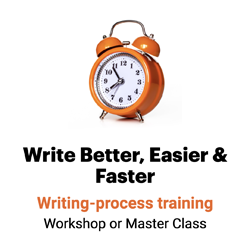Try WBHA, or writing by hanging around
You’ve heard about MBWA, or management by walking around? Try WBHA, or writing by hanging around — going to the scene to observe.

Observational research is the most overlooked reporting tool there is. Which is a shame. Because firsthand observation gives your copy color and insight that you can’t get any other way.
“You can observe a lot just by watching.”
— Yogi Berra
Observational research means that you, the writer, experience the event or product or procedure so you can recreate the experience for your readers.
- Covering a new roller coaster? Get on that sucker and ride it.
- Doing a piece on a new medical procedure? See if you can get into the operating room.
- Writing about a new line of chocolates? You haven’t really done your job until you’ve sampled a box or two.
Why observational research?
Through observational research, you show your readers what they don’t ordinarily see, make them feel what they don’t normally feel. Observational research:
- Makes writing vivid
- Helps you recreate a scene you’ve witnessed
- Turns stick figures into portraits and adjectives into sensations
- Overcomes distance, putting readers in the scene, making them feel as if they were there
How to conduct observational research
No need to interview group members or analyze data. For the structured observation research technique, you make like Yogi Berra and “observe a lot just by watching.” Here are four ways to conduct observational research:
1. Be there.
Hang up the phone, back away from the keyboard and go to the scene to observe. You can’t observe if you never leave your desk. So try these types of observational research methods:
- Spend a day (or an hour) with your subject matter expert as she goes about her regular business.
- Ask for a demonstration. Get the subject matter expert to show you how she found the computer glitch or otherwise demonstrate parts of the story for you. When writer Cynthia Gorney interviewed Theodore Geisel (Dr. Seuss) for the Washington Post, she asked him to draw one of his characters. As he sketched Yertle the Turtle, Geisel started talking about how he’d developed the character. That got the conversation rolling.
- Take a tour with the subject matter expert. Let the plant manager show you “how things work around here.”
- Find an action setting. Put yourself and your subject matter expert in a situation that reveals something about the topic. When I profiled a customer-service guru, for example, I took him to a white-tablecloth restaurant where I could observe him observing the service.
- Watch the subject in action, then talk. Be on hand while the surgeon performs surgery, for instance, then ask questions afterward.
Wherever you go, get out of your office.
“Place can provoke new information, funny stories, and great dialogue,” suggests Jeff Klinkenberg, author of Pilgrim in the Land of Alligators and other narrative nonfiction books about Florida.
“The way people talk, and what they talk about, is influenced by their surroundings. They may whisper in church, shout on the basketball court, talk nonsense after a couple of tall boys. Or they may chat about something remarkable they’ve just seen, something important.
“When you interview somebody at home, ask for a tour. Every picture, every book, every piece of furniture, can tell a story.”
2. Tune into your five senses.
Once you’ve left your desk for someplace more interesting, report with all your senses.
Remember: You have five.
Different senses affect readers differently. If you want to foster memory and emotion, for instance, focus on the sense of smell. The smell of Lipton’s tea still transports me back to my grandmother’s kitchen, circa 1972.
You can use sound, on the other hand, to build tension. From the tick-tick of the heart-beat monitor to the “Jaws” theme song, sound can create stress in your readers — stress you can “break” by showing how your organization, product or service can solve the problem.
How can you tune in to all five senses? Try this exercise recommended by Perry Garfinkel in Travel Writing: For Profit and Pleasure. Ask yourself:
“Here and now I hear what, see what, smell what, feel what, taste what?”
That way, you’ll capture, according to Kevin McGrath, assistant metro editor at The Wichita Eagle, “not just sights but sounds, smells, actions, reactions, interactions, bits of conversation, facial expressions, posture, clothing and the state it’s in (crisply pressed, badly wrinkled, sweaty, dirty, raggedy, shirttails hanging out etc.), how things look in relation to their surroundings, etc.”
You’ll see how your subject matter expert stands, sits and gestures and what she keeps on the bulletin board.
You’ll notice the sounds the machines make in different parts of the company’s plant, and how your subject’s voice tone changes when he’s feeling stressed out, passionate or joyful.
And you’ll use your senses of taste, touch and smell to recreate the scene for your readers.
“Does a clock on the wall of a high-powered executive tick-tock relentlessly, like a metronome for his pressure-packed career?” prompts David A. Fryxell, former editor of Writer’s Digest. “Do the floors of the manufacturing magnate’s office tremble with the distant pulse of the factory floor? Does the home smell of freshly baked bread, the production plant of ozone, the farm of recently spread manure?”
3. Take more notes than you use.
This ain’t data collection. This is qualitative research, not quantitative.
Still, take lots of notes about your naturalistic observations. You can always toss out whatever doesn’t make it into your piece. Pulitzer Prize-winning narrative nonfiction journalist John McPhee, for instance, might take 10,000 pages of notes for a single book.
And don’t just write down what your subject says, Fryxell suggests. Note his looks and mannerisms too.
“Do his eyebrows twitch like frenzied caterpillars when he talks?” he prompts. “What’s he wearing? Anything sticking out of his shirt pocket?”
4. Look for the telling detail.
Forget representative samples, research questions, observing participants and the Hawthorne Effect.
Instead, seek out “the Yankees cap, the neon sign in the club window, the striped towel on the deserted beach,” suggests Pulitzer Prize-winning journalist Anna Quindlen. “Those things that, taken incrementally, make a convincing picture of real life.”
That’s all you’ll need for observational research studies.
Tips for these research tools
These observational research methods can be time consuming. Observing the CEO in her natural setting is not for every story.
Deadlines and budgets force most communicators to do much of their research via phone. So ask: what story on the agenda this quarter would most benefit from observational study?
Start campaigning today for the resources to go to the scene to cover that event, issue or person.
___
Sources: Ted Anthony, “Communicating Place,” Hallmark Cards Creative Conference, 1997
David A. Fryxell, “The Observation Occupation,” Writer’s Digest, October 1997
Perry Garfinkel, Travel Writing: For Profit and Pleasure, The Penguin Group, New York, 1988
Jeff Klinkenberg, “Writing About Place: The Boundaries of a Story,” St. Petersburg Times, January 1995
Donald M. Murray, Writing to Deadline: The Journalist at Work, Heinemann, 2000
Anna Quindlen, “Writers on Writing: The Eye of the Reporter, The Heart of the Novelist,” The New York Times, Sept. 23, 2002

Leave a Reply